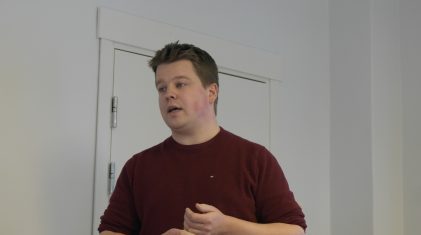Algae, plankton, insects and carbon dioxide-eating bacteria are among the solutions to ensure future aquaculture growth.
“Where will the industry in ten years?” asked Mads Martinsen, director of product development in Skretting.
He grants a short break before embarking on longer analytical reasoning.
“There will be more vegetarians, vegans and flexitarians, i.e. one who cuts out meat. I’m a flexitarian myself,” he said.
Unethical
The young director is one of the big crowd drawers at this year’s Young Fish conference in Bergen, Norway, last week. He didn’t hide the fact that he was concerned about the view that salmon is unethical.
Martinsen explained that he saw a satirical TV show that was highly critical of salmon farming. “Support the use of pesticides, the use of slaves and serious crime? Then the farmed salmon is the industry for you,” the TV show proclaimed.
“And then we laugh a little, but I don’t think it’s funny. It’s serious,” said Martinsen about the industry’s challenges on reputation.
Specifically, this applies to Dagbladet’s investigation that worked with the Future in our hands (FIVH) and the Rainforest Fund as sources, about the use of soy as feed raw materials in farmed salmon. Skretting worked with the internationally accredited classification society DNVGL to review the complex case. DNVGL found no illegal activities.
Deforestation
“But we have indirect responsibility for soy production in Brazil,” emphasised Martinsen.
Skretting sources a small share of the total, especially GM-free soy protein concentrate from Brazil. Soy, in general, has historically been a major cause of deforestation in the Amazon rainforest. The proportion has become significantly smaller in recent years, but at the same time, deforestation has again accelerated.
“With the speed that is now, we will have lost 30 per cent of the rainforest over the course of 30 years,” said Martinsen, who stressed that Skretting is not an opponent of FIVH.
“I’m cheering them on. We agree on the road ahead, but they think we should go faster,” he pointed out.
Compare
But it is also a question of who should we compare ourselves with, he said.
“Area-wise, salmon is just as good as a vegetarian dinner. Maybe we should compare ourselves with ourselves; on land use, water consumption and footprint on CO2 emissions. Where were we in 2018, where are we in 2022, 2029 and so on,” he explained.
“Skretting has quantified targets for raw materials. We have indirect responsibility for soy in Brazil. Therefore, we will not buy more soy from Brazil than we did in 2018. And it is independent of whether we will triple or fivefold the production of salmon in the future,” he said.
He said that this will place a high demand on using alternative raw materials and explained that one of the company’s goals is to use at least six per cent of so-called “new” raw materials, such as raw milk, algae oil and insect flour by 2022.
“Six per cent. It is an extremely tough target,” he said and pointed to the fact that these kinds of raw materials are considered too expensive for many farming customers.
The collaboration
He emphasised the recent work of Lerøy and Lingalaks on algae and Nordlaks who have all worked insect feed.
“More people must participate in the work,” he urged.
“When it comes to insect feed; We do not make flies, but rather larvae, before they fly. Insect feed is good at its best, but it varies greatly from batch to batch,” he said.
“Plankton are tiny crustaceans, only a few millimetres long. One cannot see it with the naked eye. It is a Norwegian adventure, a Northern Norwegian adventure. The biomass of this is more than all the seafood we harvest in Norway today. There is only one company reaping from it, a company called Raudåte. The raw material has produced good results for the salmon,” he said.
“Algae oil, it’s great fun. There we have come commercially now,” he said, highlighting the work of the subcontractor Veramaris, with whom they teamed to provide Lingalaks’ fish feed based on marine algae oil.
“They go straight to the source and farm it on land. Veramaris is now building its third factory, and this cost costs NOK 2 billion*. That factory alone will cover the entire Skretting needs for omega 3,” he added.
A trip to Mars
“We often talk about cutoffs, but we are not talking about cutoffs from chicken and pigs. There are great resources,” he noted.
Another resource is CO2-eating bacteria as feed raw material, based on an idea that was developed in connection with a planned voyage in space. The question was what the astronauts should eat when NASA was to send them to March.
“NASA found a bacterial species that exploits what astronauts produce, namely CO2. Then NASA never went to Mars and the technology was forgotten. But now it has come back, and our owners, Nutreco, want to build a factory that can produce 100,000 tonnes of this, most likely in the US,” he concluded.

